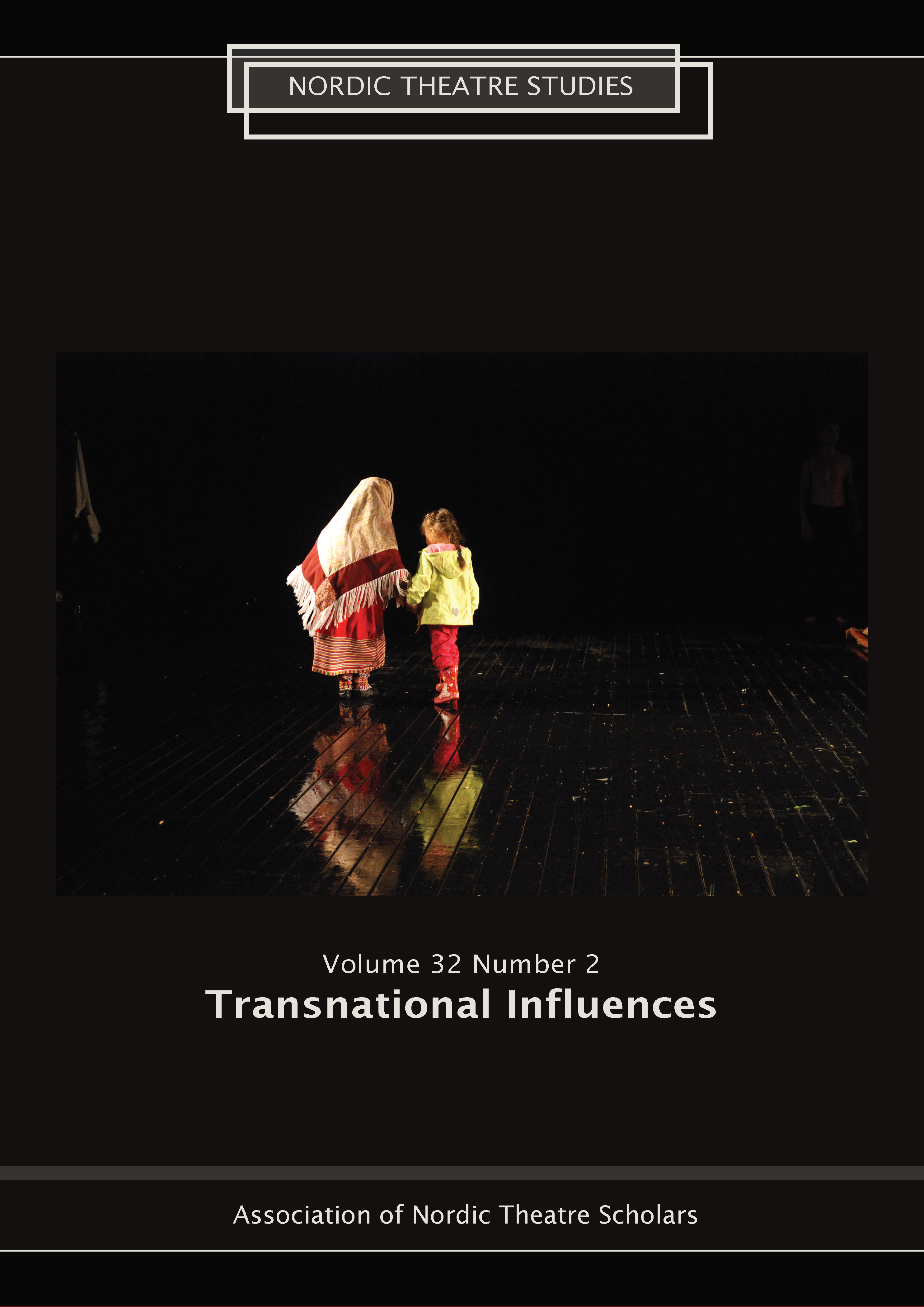Constructing Finno-Ugric Identity through Theatre
DOI:
https://doi.org/10.7146/nts.v32i2.124358Keywords:
Finno-Ugric identity, minority identity, transnational performance, Estonian theatre, Mayatul, Anne TürnpuAbstract
The article investigates the construction of transnational Finno-Ugric identity through the theatre festival Mayatul and different performative strategies. This kind of identity construction is investigated through the framework of identity politics and transnationalism. The definition of the Finno-Ugric peoples (Finns, Estonians, Hungarians, Samis, Mordvins, Komi, Udmurts and others) is based foremost on their language kinship. It is believed that similar characteristics of languages and a similar natural environment and climate have shaped the close-to-nature lifestyle and the particular perception of the world shared by the Finno-Ugric peoples.
Essential platforms for constructing transnational Finno-Ugric identity are different theatre festivals, among which Mayatul (since 1992) is the most prominent. The majority of productions at the festival are performed in Finno-Ugric languages and interpret the literary texts or folklore of these peoples. However, only a few productions strive for indigenous aesthetics like those of Estonian theatre director Anne Türnpu.
The Finno-Ugric peoples’ identity is predominantly a minority identity because mostly they represent a small national and language group in a bigger state like Russia, and only Finland and Hungary have enjoyed one hundred years of independence. Nevertheless, all countries and nations embrace smaller ethnic or cultural minorities, thus minority identity is a universal concept. Theatre festivals are able to unite minority identities into larger transnational identites, even when it is just an imagined community.
References
Arukask, Madis. 2018. “Soomeugrilusest eesti rahvuspildis – kas jagatud emotsioon või hägune küsitavus?” Keel ja Kirjandus 1–2, 104–117.
Bauman, Zygmunt. 2004. Identity: Conversations with Benedetto Vecchi. Cambridge: Polity Press.
Cagnoli, Sébastien. 2013. “The role of drama in the construction of national identities in the Ural-Volga area, through examples of Finno-Ugric interaction.” Researchgate, https://www.researchgate.net/publication/328842367 (6.7.2020).
ETY = Eesti Etümoloogiasõnaraamat, https://www.eki.ee/dict/ety/index.cgi?Q=tuli&F=M&C06=et (15.2.2020).
Hall, Stuart. 1996. “Introduction: Who needs identity?” In Stuart Hall, Paul du Gay (eds.). Questions of Cultural Identity. Los Angeles, London etc.: Sage, 1–17.
Holdsworth, Nadine. 2014. “Introduction.” In N. Holdsworth (ed.). Theatre and National Identity: Re-imagining Conceptions of Nation. London, New York: Routledge, 1–16.
Kuutma, Kristin. 1998. “Festival as communicative performance and celebration of ethnicity.” Folklore 7, https://www.folklore.ee/folklore/vol7/festiva.htm (12.1.2020).
Kuutma, Kristin. 2005. “Vernacular religions and the invention of identities behind the Finno-Ugric Wall.” Temenos : Nordic Journal of Comparative Religion, 41:1, 51−76.
Laasik, Andres. 1992. “Surevate rahvaste teatri pidu”. Teater. Muusika. Kino 7, 63–65.
Linder, Eva-Liisa. 2019. “Three Phases of the Theatrical Public Sphere in Estonian Theatre.” Nordic Theatre Studies 31:1, 73–91.
Masing, Uku. 1993. “Hüpoteetilist eesti keele psühholoogiast.” In Uku Masing. Vaatlusi maailmale teoloogi seisukohalt. Tartu: Ilmamaa, 51–55.
Prozes, Jaak. 2012. “Hõimuliikumine ja Fenno-Ugria Asutus.” Soome-ugri sõlmed 2010–2011. Tallinn: Fenno-Ugria, 104–114.
Prozes, Jaak. 2014. “Hõimuliikumise unistused ja reaalsus 1980ndate lõpus ja 1990ndate alguses.” Soome-ugri sõlmed 2013. Tallinn: Fenno-Ugria, 16–19.
Raudalainen, Viia-Kadi. 2019. “Muljeid 12. soome-ugri teatrifestivalilt Majatul.” Soome-ugri sõlmed 2018. Tallinn: Fenno-Ugria, 128–132.
Reinelt, Janelle. 2005. “National signs: Estonian identity in performance.” Sign Systems Studies, 33:2, 369–378.
Schoenmakers, Henri. 2007. “Festivals, theatrical events and communicative interactions.” In Temple Hauptfleisch, Shulamith Lev-Aladgem, Jacqueline Martin, Willmar Sauter, Henri Schoenmakers (eds.). Theatrical Events, Politics and Culture. Amsterdam, New York: Rodopi.
Smith, Anthony D. 1991. National identity. Reno: University of Nevada Press.
Stoeltje, Beverly J. 1992. “Festival.” In Richard Bauman (ed.). Folklore, Cultural Performances and Popular Entertainments. New York, Oxford: Oxford University Press, 261–271.
Suits, Gustav. 2002. “Kultuur ja sõda: 1905–1915.” – Vabaduse väraval. Tartu: Ilmamaa, 64–72.
Thiel, Markus and Rebecca Friedman. 2012. “Introduction: culture and narratives of transnational belonging.” European Identity and Culture: Narratives of Transnational Belonging. London, New York: Routledge, 1–16.
Türnpu, Anne e-mail 21.3.2019 to the author(s).
Türnpu, Anne interview 5.2.2020. Interviewed by the author(s).
Viluoja, Eha. 2013. “Fenno-Ugria jututuba: Sugrierroriga Saranskis.” Soome-ugri sõlmed 2012. Tallinn: Fenno-Ugria, 143–153.
Newspapers
Ala, Janar. 2011. “Kus viga näed laita, seal ära aita – teater, mis uurib sugri tehnoteadvust.” Postimees, 31.8.2011.
Linder, Eva-Liisa. 2011. “Sugri error on nihe meie maailma ja realiteedi vahel. Interview with Anne Türnpu.“ Sirp, 26.8.2011.
Moring, Kirsikka. 2012. “Kaikki me olemme venäläisiä.” Helsingin Sanomat, 25.11.2012.
Kulbayeva, Natalja. 2009 = Kульбaeвa Нaтaлиa. “Фестиваль ‘Maйaтул’: прoйдeннoe и пeрcпeктивы.” Финно-угорский культурный центр Российской Федерации webpage, http://www.finnougoria.ru/news/publications/9247/ (15.3.2019)
Sallamaa, Kari. 1999. “Uku Masing as the Pioneer of Ethnofuturism.” Suri web archaive, http://www.suri.ee/etnofutu/vanaisad/masing/sall-uku.html (7.7.2020).
Webpages
“Finno-Ugrians, who are they?” Eesti rahvaluule webpage, http://www.folklore.ee/ugri/fu/whougri.html (23.2.2020).
“Finno-Ugric Peoples.” Fenno-Ugria webpage, https://eng.fennougria.ee/peoples/ (20.2.2020).
“Setod.” Fenno-Ugria webpage, https://fennougria.ee/rahvad/laanemeresoome-rahvad/eestlased/setod/ (25.2.2019).
“Soome-ugri teater ei ole surnud − see elab!” Fenno-Ugria webpage, https://fennougria.ee/soomeugriteater-ei-ole-surnud-%E2%88%92-see-elab/ (28.2.2020).
Downloads
Published
How to Cite
Issue
Section
License
The copyright belongs to the authors and Nordic Theatre Studies. Users can use, reuse and build upon the material published in the journal but only for non-commercial purposes. Users are allowed to link to the files, download the files, distribute the files on a local network (preferably by links), upload the files to local repositories if their institutions require them to do so, but not republish the files without proper agreements with the journal and the author.

